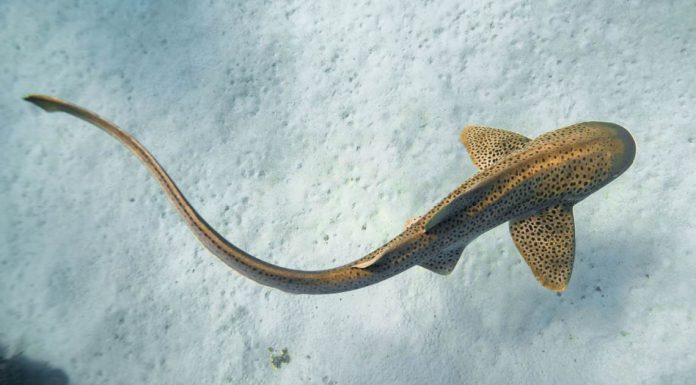When you hear the word “shark,” what comes to mind? For many, movies like Jaws, The Meg, or The Shallows feature front and center. Over the years, these blockbusters have entertained audiences while raking in the big bucks. But they’ve also shrouded our perceptions of sharks in terror.
Sharks fall under the larger umbrella of cartilaginous fishes, along with rays, and both have more to fear from humans than humans do from them. Of the thousands of shark and ray species on the planet, about one-third face extinction. The reason? A perfect storm of overfishing and ecosystem collapse.
Fortunately, zebra sharks (Stegostoma tigrinum) are helping researchers develop new conservation strategies. Along the way, scientists have learned about zebra sharks’ ability to reproduce asexually (known as parthenogenesis) and the unique egg-prints (like fingerprints) distinct to each shark mom.
Shark Populations are Quickly Declining
With more than 70 percent of all shark and ray species in decline, scientists are in a race against time. And the implications of not winning this race could prove devastating. After all, many species of sharks are apex predators. They play a vital role in keeping our oceans healthy, balanced, and functioning properly.
How do we help cartilaginous fish populations rebound? That’s a question Dr. Kady Lyons of Georgia Aquarium and Dr. Jennifer Wyffels of Ripley’s Aquariums decided to find out firsthand. They collaborated with the SAFE Shark and Ray Program, accredited by the Association of Zoos and Aquariums (AZA), to uncover potential answers within zebra shark populations.
How Studying Zebra Sharks Can Help
Funded through an AZA Conservation Grant, Lyons and Wyffels focused on crucial questions related to zebra shark productivity. These questions included:
- How many eggs does a female zebra shark lay in a season?
- Which months are they most productive?
- How often does asexual reproduction (known as parthenogenesis) occur?
- When is male zebra shark semen most likely to result in shark babies?
How did Lyons and Wyffels gather this data? By enlisting a team of researchers to collect information about 22 females, five males, and 2,410 shark eggs from ten institutions.
They employed various techniques and technologies, including old-fashioned physical exams, ultrasounds, and blood panels. In particular, the ultrasounds allowed the scientists to peek inside zebra sharks’ internal reproductive anatomy. Combined with regular blood tests to monitor hormone levels, researchers gained a more accurate picture of reproductive seasonality in zebra sharks.
Asexual Reproduction: A Not-So-Super Power
How do things like parthenogenesis fit into the zebra shark reproductive cycle? This phenomenon allows female sharks to reproduce alone, without the input of a male zebra shark. The result? Carbon copies of mom.
While you’d think that asexual reproduction represents a miracle process with the potential to save zebra shark populations, think again. Parthenogenesis results in parthenotes.
What’s the problem with parthenotes? Since they are created solely out of the mother’s genetic material, they lack genetic diversity. Think of them as imperfect copies of their female parent. Each copy drastically limits the genetic variety of the species — no bueno for population expansion.
Egg-Prints and Genetic Testing
During their research, Lyons and Wyffels discovered that parthenogenesis happened at least once for most zebra shark females. But how could they be sure which eggs belonged to which shark? By recording the “egg-print” of each female shark. Like fingerprints, the characteristics of eggs are unique to every laying female.

Dr. Kady Lyons of Georgia Aquarium and Dr. Jennifer Wyffels of Ripley’s Aquariums studied hundreds of zebra shark eggs to uncover valuable information that will help with the conservation of the species. Image credit: Akhilesh K.V. / FishBase
This allowed the researchers to identify offspring born in tanks frequented by multiple females. But it didn’t give any indications about which babies were parthenotes. To get to the bottom of this, researchers relied on genetic testing.
The Takeaway: Zebra Shark Reproductive Research
What’s the takeaway regarding the work done by Lyons, Wyffels, and their team? Their data will be used to further zebra shark conservation through the Stegostoma tigrinum Augmentation and Recovery (StAR) Project. Their ultimate goal? Bringing zebra sharks back in abundance to their native waters off the coast of Indonesia.
To achieve this, the data will be used to match male and female sharks. This will help ensure the greatest genetic health and diversity across institutions, nationally and internationally. The eggs these breeding pairs produce will head to Indonesia for hatching and release into protected areas.
Most importantly, by understanding the reproductive cycle of zebra sharks, conservationists can avoid relocating parthenotes to Southeast Asia. It’s an egg-cellent step in the right direction for ocean health and renewal!
Want to catch these beautiful sharks up close and in person? Add Ripley’s Aquarium of Canada to your next travel plans for a jaw-some time!
By Engrid Barnett, contributor for Ripleys.com
EXPLORE THE ODD IN PERSON!
Hits: 0










